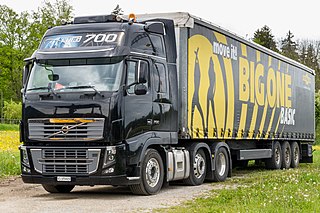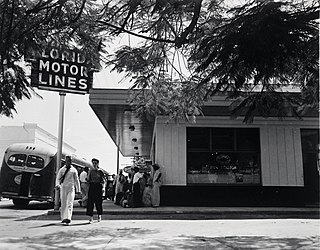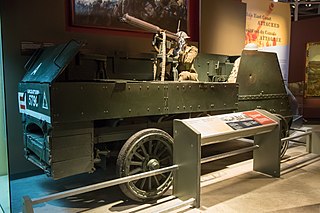The White Motor Company was an American automobile, truck, bus and agricultural tractor manufacturer from 1900 until 1980. The company also produced bicycles, roller skates, automatic lathes, and sewing machines. Before World War II, the company was based in Cleveland, Ohio. White Diesel Engine Division in Springfield, Ohio, manufactured diesel engine generators, which powered U.S. military equipment and infrastructure, namely Army Nike and Air Force Bomarc launch complexes, and other guided missile installations and proving grounds, sections of SAGE and DEW Line stations, radars, Combat Direction Centers and other ground facilities of the U.S. aerospace defense ring, such as the Texas Towers.
GMC, formerly the General Motors Truck Company, or the GMC Truck & Coach Division, is a division of the American automobile manufacturer General Motors (GM) that primarily focuses on trucks and utility vehicles. GMC currently makes SUVs, pickup trucks, vans, and light-duty trucks, catered to a premium-based market. In the past, GMC also produced fire trucks, ambulances, heavy-duty trucks, military vehicles, motorhomes, transit buses, and medium duty trucks.
Toyota Motor North America (TMNA) is the operating subsidiary that oversees all operations of the Toyota Motor Corporation in Canada, Mexico, and the United States. Its operations include research and development, manufacturing, sales, marketing, after sales and corporate functions, which are controlled by TMNA but sometimes executed by other subsidiaries and holding companies. The company is headquartered in Plano, Texas, with major offices in Georgetown, Kentucky, Ann Arbor, Michigan, Washington, D.C., New York City and other regional offices.

Lambda is the name of a series of Japanese carrier rockets. It consisted of the types Lambda 2, LS-A, LSC-3, Lambda 3, Lambda 4 and LS-C, developed jointly by Institute of Industrial Science of University of Tokyo, Institute of Space and Astronautical Science of Tokyo University, and Prince Motor Company, which merged with Nissan in 1966.

The Autocar Company is an American specialist manufacturer of severe-duty, Class 7 and Class 8 vocational trucks, with its headquarters in Birmingham, Alabama. Started in 1897 in Pittsburgh, Pennsylvania, as a manufacturer of Brass Era automobiles, and trucks from 1899, Autocar is the oldest surviving motor vehicle brand in the Western Hemisphere.

All the Right Moves is a 1983 American sports drama film directed by Michael Chapman and starring Tom Cruise, Craig T. Nelson, Lea Thompson, Chris Penn, and Gary Graham. It was filmed on location in Johnstown, Pennsylvania, and Pittsburgh.

The South Fork Fishing and Hunting Club was a Pennsylvania corporation which operated an exclusive and secretive retreat at a mountain lake near South Fork, Pennsylvania, for more than fifty extremely wealthy men and their families. The club was the owner of the South Fork Dam, which failed during an unprecedented period of heavy rains, resulting in the disastrous Johnstown Flood on May 31, 1889.

Horace Elgin Dodge Sr. was an American automobile manufacturing pioneer and co-founder of Dodge Brothers Company.

WTCN-CD, virtual channel 43, is a low-power, Class A MyNetworkTV-affiliated television station licensed to Palm Beach, Florida, United States, serving the Gold and Treasure Coasts of South Florida. Owned by Hunt Valley, Maryland-based Sinclair Broadcast Group, it is a sister station to West Palm Beach-licensed CBS affiliate WPEC, Fort Pierce-licensed CW affiliate WTVX, and Stuart-licensed Class A Azteca América affiliate WWHB-CD. The stations share studios on Fairfield Drive in Mangonia Park, while WTCN-CD's transmitter is located southwest of Hobe Sound, Florida.

Palm Beach County Fire Rescue is one of the largest fire departments in the State of Florida. Palm Beach County Fire Rescue provides fire protection, Advanced Life Support emergency medical services, technical rescue, hazardous materials mitigation, aircraft rescue and firefighting, fire investigation, and 911 dispatching for unincorporated parts of Palm Beach County, Florida and 19 cities under contract.

Cab-over, also known as cab over engine (COE), cab forward (U.S.), flat nose (Canada), or forward control (UK), is a body style of truck, bus, or van that has a vertical front, "flat face" or a semi-hood, with the cab of the truck sitting above the front axle. This contrasts with a conventional truck where the engine is mounted in front of the driver.

Palm Tran is the public transit bus system run by the Palm Beach County Government, serving Palm Beach County, Florida. During fiscal year 2015, Palm Tran provided 10,773,132 one-way passenger trips and 889,056 paratransit trips to Palm Beach County. Palm Tran also serves a portion of Broward County, Florida where it overlaps with Broward County Transit. Palm Tran has four main facilities with its main headquarters in West Palm Beach on Electronics Way. The current Executive Director is Clinton B. Forbes.

The Davidson-Duryea gun carriage was a 3- and 4-wheeled armed armored vehicle manufactured in 1898 and 1899 for military use.

The Florida Greyhound Lines, a highway-coach carrier, was a Greyhound regional operating company, based in Jacksonville, Florida, USA, from 1946 until 1957, when it was merged into the Southeastern Greyhound Lines, a neighboring operating company.

Kahn Design is a British-based company that specialises in the modification of motor vehicles. Founded by Afzal Kahn, the company has its headquarters in Bradford and showrooms in both Chelsea and Kensington in London.

The Traffic Motor Truck Corporation (TMTC) was a St. Louis truck manufacturer from 1917 to 1929. It used Continental engines chiefly, and sometimes Gray Victory engines. The company was based at 5200 North Second Street. Guy C. Wilson was TMTC's president and Theodore C. Brandle was its vice president. Stephen W. Avery was the company's advertising manager.

Volvo Trucks Corporation, stylized as VOLVO, is a global truck manufacturer based in Gothenburg, Sweden, owned by AB Volvo. In 2016, it was the world’s second largest manufacturer of heavy-duty trucks.

The Armoured Autocar was a Canadian armoured car used as a mobile machine gun nest during the First World War.

Borgward Group AG is a German-based automobile brand established in May, 2008 with headquarter in Stuttgart, Germany. The company carries the name and logo of the former German brand Borgward. Design and engineering is located in Germany, but the cars are produced in China by Foton Motor.
Marek Djordjevic is a Serbian automobile-designer known for the Rolls-Royce Phantom VII luxury car.
















